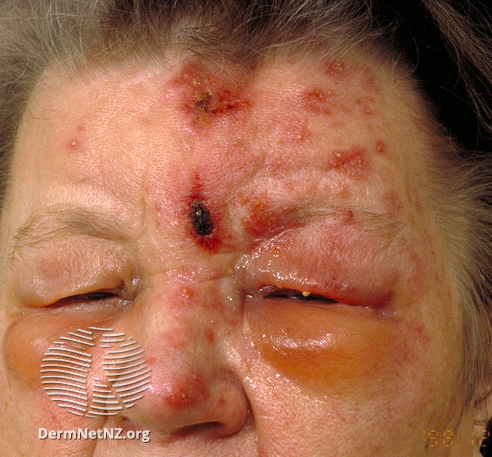[1]
HOPE-SIMPSON RE. THE NATURE OF HERPES ZOSTER: A LONG-TERM STUDY AND A NEW HYPOTHESIS. Proceedings of the Royal Society of Medicine. 1965 Jan:58(1):9-20
[PubMed PMID: 14267505]
[2]
Liesegang TJ. Herpes zoster ophthalmicus natural history, risk factors, clinical presentation, and morbidity. Ophthalmology. 2008 Feb:115(2 Suppl):S3-12. doi: 10.1016/j.ophtha.2007.10.009. Epub
[PubMed PMID: 18243930]
[3]
Weinberg JM. Herpes zoster: epidemiology, natural history, and common complications. Journal of the American Academy of Dermatology. 2007 Dec:57(6 Suppl):S130-5
[PubMed PMID: 18021864]
[4]
Borkar DS, Tham VM, Esterberg E, Ray KJ, Vinoya AC, Parker JV, Uchida A, Acharya NR. Incidence of herpes zoster ophthalmicus: results from the Pacific Ocular Inflammation Study. Ophthalmology. 2013 Mar:120(3):451-456. doi: 10.1016/j.ophtha.2012.09.007. Epub 2012 Dec 1
[PubMed PMID: 23207173]
[5]
Kong CL, Thompson RR, Porco TC, Kim E, Acharya NR. Incidence Rate of Herpes Zoster Ophthalmicus: A Retrospective Cohort Study from 1994 through 2018. Ophthalmology. 2020 Mar:127(3):324-330. doi: 10.1016/j.ophtha.2019.10.001. Epub 2019 Oct 9
[PubMed PMID: 31668889]
Level 2 (mid-level) evidence
[6]
Brisson M, Edmunds WJ, Law B, Gay NJ, Walld R, Brownell M, Roos LL, De Serres G. Epidemiology of varicella zoster virus infection in Canada and the United Kingdom. Epidemiology and infection. 2001 Oct:127(2):305-14
[PubMed PMID: 11693508]
[7]
Zerboni L, Sen N, Oliver SL, Arvin AM. Molecular mechanisms of varicella zoster virus pathogenesis. Nature reviews. Microbiology. 2014 Mar:12(3):197-210. doi: 10.1038/nrmicro3215. Epub 2014 Feb 10
[PubMed PMID: 24509782]
[8]
Kalogeropoulos CD, Bassukas ID, Moschos MM, Tabbara KF. Eye and Periocular Skin Involvement in Herpes Zoster Infection. Medical hypothesis, discovery & innovation ophthalmology journal. 2015 Winter:4(4):142-156
[PubMed PMID: 27800502]
[9]
Tabery HM. Morphology of epithelial keratitis in herpes zoster ophthalmicus. A non-contact photomicrographic in vivo study in the human cornea. Acta ophthalmologica Scandinavica. 2000 Dec:78(6):651-5
[PubMed PMID: 11167225]
[10]
Cobo LM. Corneal complications of herpes zoster ophthalmicus. Prevention and treatment. Cornea. 1988:7(1):50-6
[PubMed PMID: 3258220]
[11]
Catron T, Hern HG. Herpes zoster ophthalmicus. The western journal of emergency medicine. 2008 Aug:9(3):174-6
[PubMed PMID: 19561738]
[12]
Hoeksema L, Jansonius NM, Los LI. Risk Factors for Secondary Glaucoma in Herpetic Anterior Uveitis. American journal of ophthalmology. 2017 Sep:181():55-60. doi: 10.1016/j.ajo.2017.06.013. Epub 2017 Jun 27
[PubMed PMID: 28666730]
[13]
Mueller NH, Gilden DH, Cohrs RJ, Mahalingam R, Nagel MA. Varicella zoster virus infection: clinical features, molecular pathogenesis of disease, and latency. Neurologic clinics. 2008 Aug:26(3):675-97, viii. doi: 10.1016/j.ncl.2008.03.011. Epub
[PubMed PMID: 18657721]
[14]
Opstelten W, van Loon AM, Schuller M, van Wijck AJ, van Essen GA, Moons KG, Verheij TJ. Clinical diagnosis of herpes zoster in family practice. Annals of family medicine. 2007 Jul-Aug:5(4):305-9
[PubMed PMID: 17664496]
[15]
Harbecke R, Oxman MN, Arnold BA, Ip C, Johnson GR, Levin MJ, Gelb LD, Schmader KE, Straus SE, Wang H, Wright PF, Pachucki CT, Gershon AA, Arbeit RD, Davis LE, Simberkoff MS, Weinberg A, Williams HM, Cheney C, Petrukhin L, Abraham KG, Shaw A, Manoff S, Antonello JM, Green T, Wang Y, Tan C, Keller PM, Shingles Prevention Study Group. A real-time PCR assay to identify and discriminate among wild-type and vaccine strains of varicella-zoster virus and herpes simplex virus in clinical specimens, and comparison with the clinical diagnoses. Journal of medical virology. 2009 Jul:81(7):1310-22. doi: 10.1002/jmv.21506. Epub
[PubMed PMID: 19475609]
[16]
Neoh C, Harding SP, Saunders D, Wallis S, Tullo AB, Nylander A, Nelson ME. Comparison of topical and oral acyclovir in early herpes zoster ophthalmicus. Eye (London, England). 1994:8 ( Pt 6)():688-91
[PubMed PMID: 7867830]
[17]
Morton P, Thomson AN. Oral acyclovir in the treatment of herpes zoster in general practice. The New Zealand medical journal. 1989 Mar 8:102(863):93-5
[PubMed PMID: 2648213]
[18]
Ormrod D, Goa K. Valaciclovir: a review of its use in the management of herpes zoster. Drugs. 2000 Jun:59(6):1317-40
[PubMed PMID: 10882165]
[19]
Tyring SK. Efficacy of famciclovir in the treatment of herpes zoster. Seminars in dermatology. 1996 Jun:15(2 Suppl 1):27-31
[PubMed PMID: 8840413]
[20]
Tricco AC, Zarin W, Cardoso R, Veroniki AA, Khan PA, Nincic V, Ghassemi M, Warren R, Sharpe JP, Page AV, Straus SE. Efficacy, effectiveness, and safety of herpes zoster vaccines in adults aged 50 and older: systematic review and network meta-analysis. BMJ (Clinical research ed.). 2018 Oct 25:363():k4029. doi: 10.1136/bmj.k4029. Epub 2018 Oct 25
[PubMed PMID: 30361202]
Level 1 (high-level) evidence
[21]
Bharucha T, Ming D, Breuer J. A critical appraisal of 'Shingrix', a novel herpes zoster subunit vaccine (HZ/Su or GSK1437173A) for varicella zoster virus. Human vaccines & immunotherapeutics. 2017 Aug 3:13(8):1789-1797. doi: 10.1080/21645515.2017.1317410. Epub 2017 Apr 20
[PubMed PMID: 28426274]
[22]
Gilden D. Efficacy of live zoster vaccine in preventing zoster and postherpetic neuralgia. Journal of internal medicine. 2011 May:269(5):496-506. doi: 10.1111/j.1365-2796.2011.02359.x. Epub 2011 Feb 23
[PubMed PMID: 21294791]
[23]
Chua JV, Chen WH. Herpes zoster vaccine for the elderly: boosting immunity. Aging health. 2010 Apr 1:6(2):169-176
[PubMed PMID: 20607105]

